Torrance Art Museum SUR:Biennial 2019
SUR:Biennial > 2019 > Torrance Art Museum
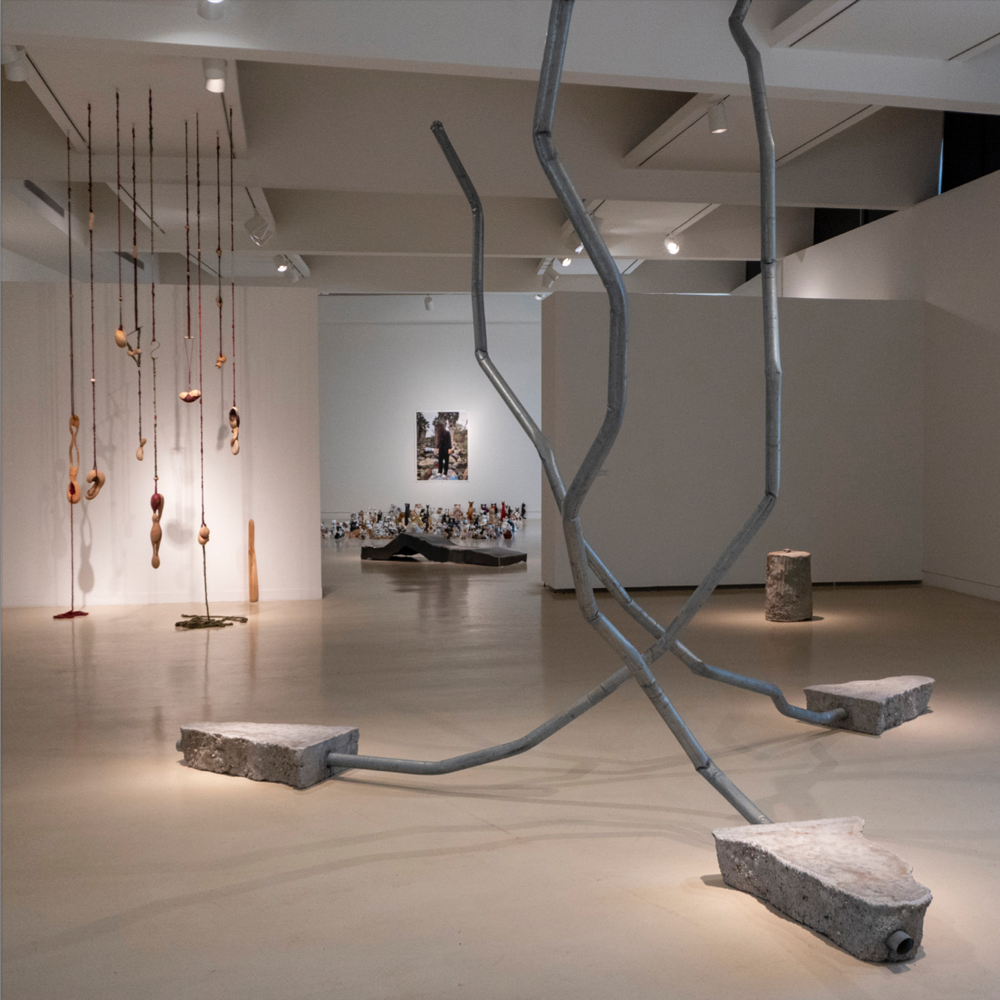 Torrance Installation Shot.
Torrance Installation Shot.
MATERIAL MATTERS
Material Matters presents four artists who gather together the materials of urban life here in Southern California - plastics, steel, concrete, fabrics, detritus – and manipulate them in order to address themes of Identity, Memory, political positions and the poetics of the urban environment.
These materials, that contextualize their practice within a very contemporary city, are discovered and utilized to bring a fresh insight into what it might mean to be urban. This Flaneur aspect of living in the metropolis identifies the link between materiality and meaning in a way that situates it to a specific time and place, both a perceptual location and an experiential particularity.
These are the materials of the City. This is about the experience of living somewhere rather than visiting, about the core symbiosis between physical elements and identity...
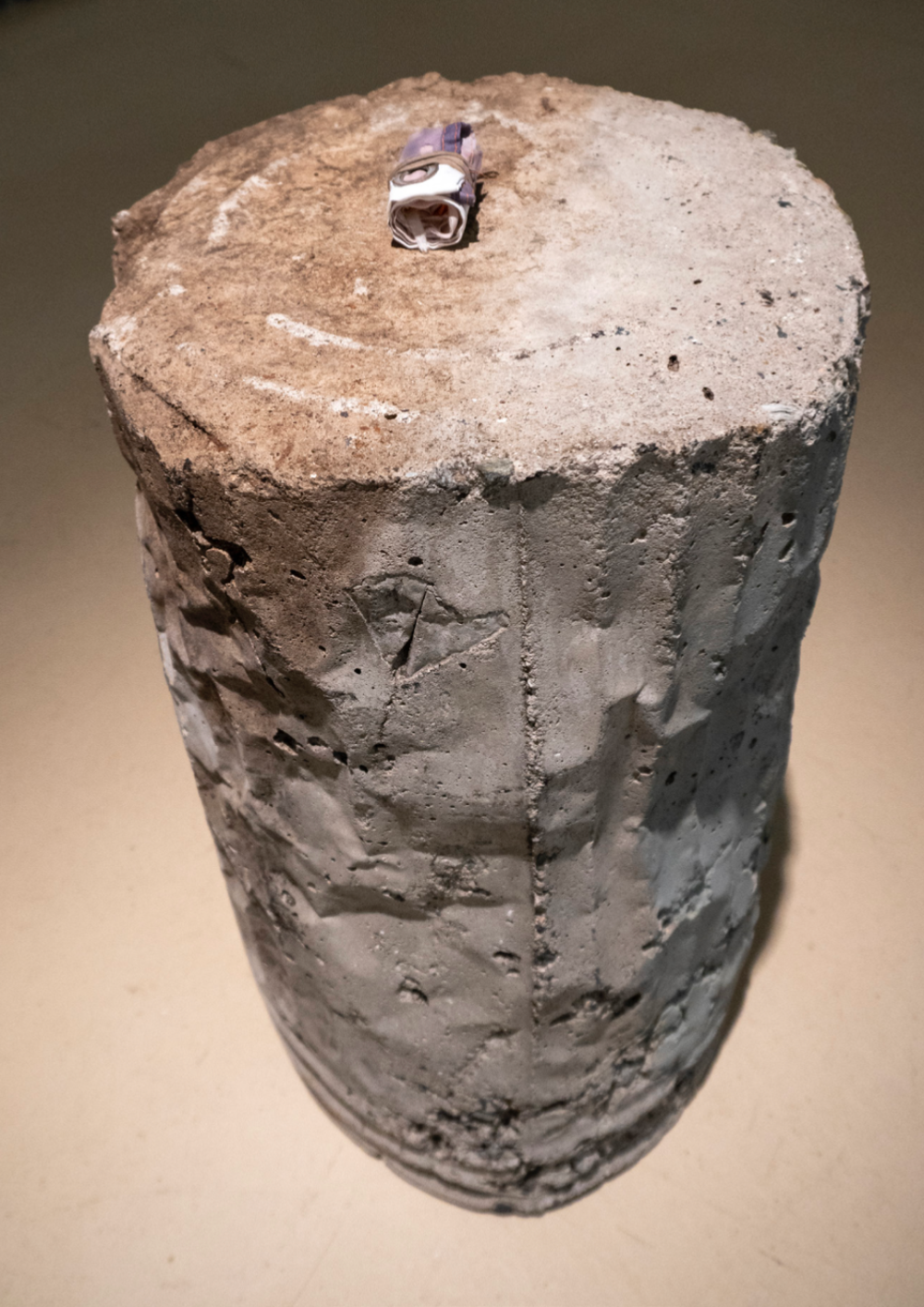
Cruz Castillo, A Monument to Liberty, Cement, Rubber Bands & American Flag, 22.5"
x 14" x 16", 2019.
Cruz Castillo
Cruz Castillo goes on walks around the city as part of his practice. While on these travels throughout the city’s streets, he examines the sculptural landscape the public sphere has to offer and begins to see the repetition of objects that make up the urban space. He gravitates toward the objects that are constitutive of the public realm of each neighborhood he navigates through in order to find the poetics within the subtle gestures each object holds within the fabric of the environment.
The transformation of information composed from material elements of my biracial background is constitutive of my trajectory. Questioning symbolic identity, dependent upon the Chicano and Anglo-American notions of authenticity, I confront the marriage between subject and object. As a participant immersed in a peculiar environment, my work creates a discourse with my surroundings, investigating the relations maintained by objects, and the metaphorical experiences they share apart from us.
Drawing on the strength of rough, found materials encrusted with testaments to history, I detach the utilitarian purpose an object possesses, and use these readymades as an instrument of awareness to the poetics of everyday life, re-categorizing reality shaping representations that transcend the locations where the object originated, emphasizing the ambiguity of living and heightening the consciousness of existence.
With humor as a tool for seduction, I defy the principles of efficacy and productivity by challenging cognitive structures. The rehabilitation of form operates within the synchronous act of de-assembling the objects’ semiotics and re-contextualizing the conceptual landscape of its being. Hierarchal relationships between objects are complicated by the creation of the hybrid form that exceeds the fixed definition of imposed identities, while refiguring the aesthetic value of each material. Activity turns into form: a vehicle for invention and creation.
Because of my mixed heritage, I exist between two dialectical energies, struggling to discover a balance between them both. This is the reason why I engage in disassembling objects transfixed with essentialisms, shaping new conversations. In showcasing objects intertwined and embedded with the weight of cultural history and tradition – illustrative of my own dual identification – my work intends to spotlight a dialogue of social inequalities within our habitual way of thought.
Cruz Castillo is currently working on his MFA at UCLA. He has exhibited at the Godine Gallery (Boston), the Forge (Detroit), and the LaVerne Krause Gallery (Eugene, OR).
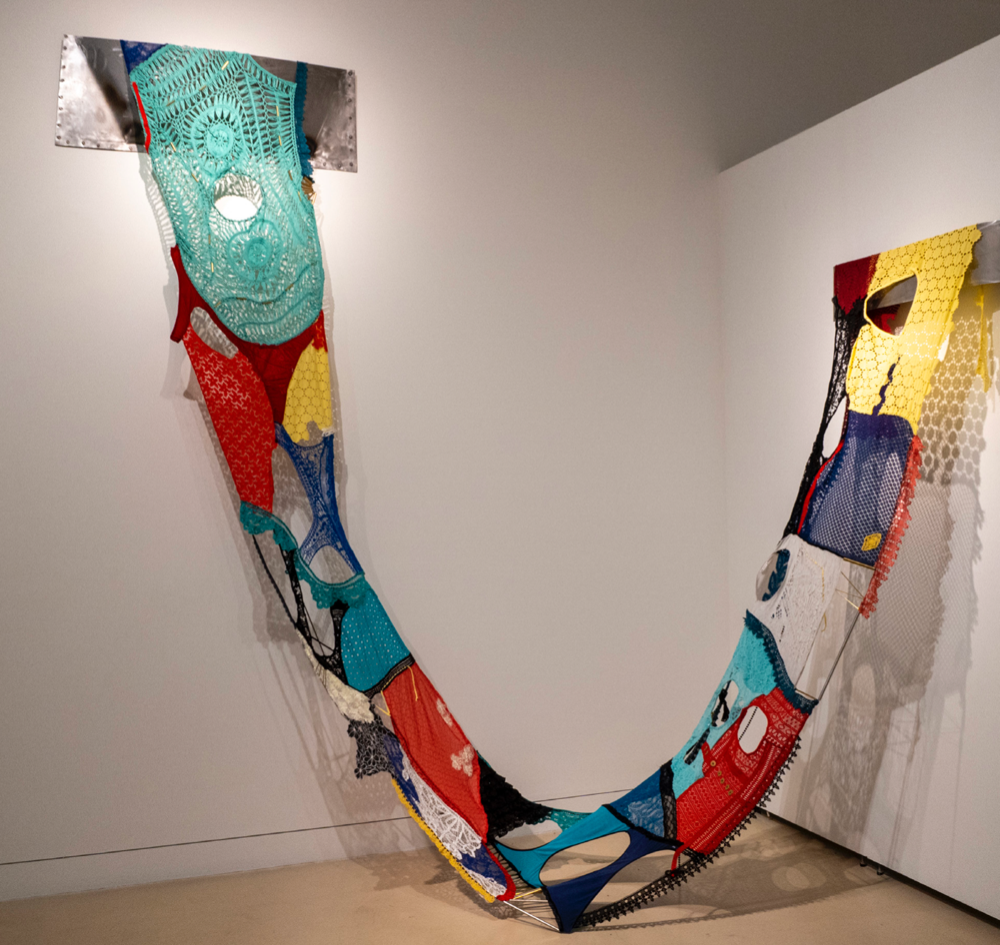
Elisa Ortega Montilla, Ni Una Mas, Ni Una Menos, Mixed Media, 32" x 264", 2019.
Elisa Ortega Montilla
Growing up in the 1980s in Spain, ten years after the country transitioned from dictatorship
to democracy, marked the way Elisa Ortega Montilla relates to materials in her art
practice. She grew up hearing stories from her grandmother about the Spanish Civil
War while she mended hand-me- downs from her cousins. What was a result
of economic austerity from the Franco years later became an ethical choice. Her work
explores three fundamental parts of who she is: her experience of being a woman and
her feminist values; her feelings of acculturation from living in the US as an immigrant
while maintaining her Spanish identity; and her opposition to consumerism and commitment
to environmental sustainability.
Her practice uses installation, wood sculptures, and reclaimed and overlooked textiles, addressing themes of memory, transformation, adaptation, and identity through materials that have been discarded, deconstructed, and reconstructed. She mixes the found and the made, the new and the old; tradition and experimentation; the mass-produced and the handmade; her Spanish values and American experience; and the present and the past. She is drawn to the expressive and experiential nature of abstraction because it provides her with a universal language that transcends regions, structures, and categories. Non-binary anthropomorphic volumes, bodily suggestions, sensual movements, and feminine shapes are oblique references to the human condition and a soft invocation of the female body.
Elisa Ortega Montilla lives and works in Santa Barbara. She graduated in 2006 from
Pablo de Olavide College, Seville, with a bachelor’s degree in Social Work and has
a Masters in Education and Human Rights from the University of Córdoba, Spain. A
social worker with over a decade of experience, she has worked with groups as diverse
as drug addicts; victims of domestic violence; the gypsy community in Spain; homeless
LGBT youth and adults with intellectual disabilities in Los Angeles. She has always
incorporated art as a tool to empower the communities with which she works. Montilla
has studied art in public and private institutions, including at
the University of California, Los Angeles and the Complutense University in Madrid.
Her work has been featured in the Los Angeles Times, the Los Angeles Review of Books,
Hyperallergic, KCRW, and the University of California’s Women’s Month. Her work has
been exhibited in group and solo exhibitions in Spain, Guatemala, and California.
She recently completed a Master of Fine Arts at the University of California, Santa
Barbara and was chosen as the university’s 2019-2020 Artist-in- Residence.
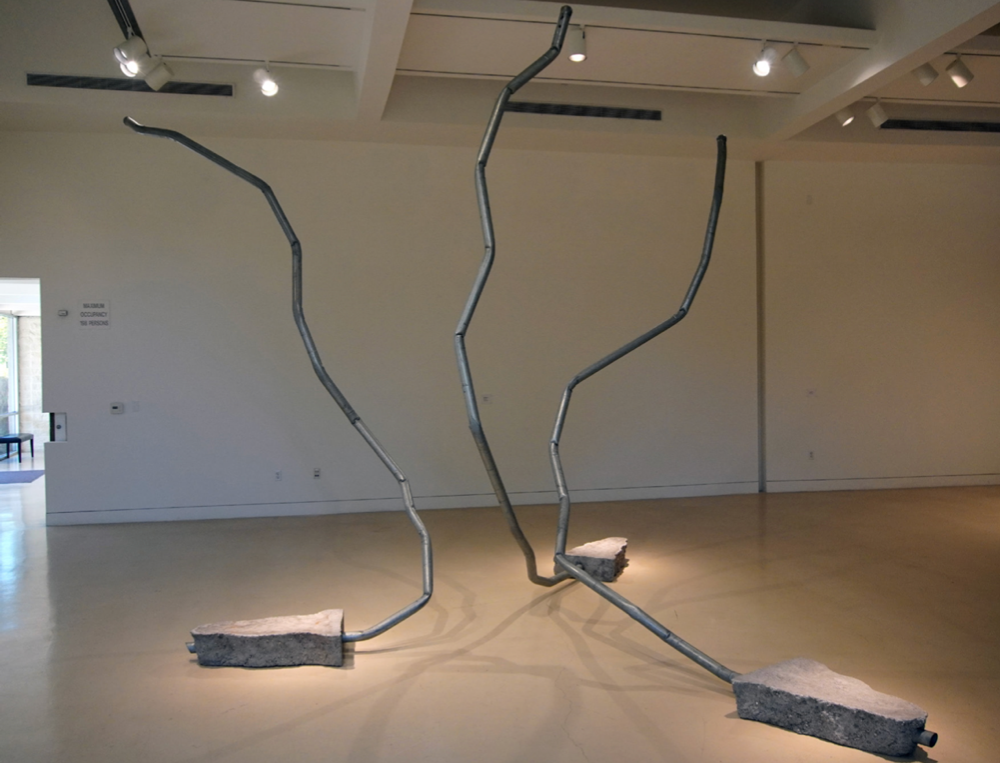
Ruben Ochoa, Ever Since I Was Little It Looked Like Fun, Concrete and Steel, Dimensions
Variable, 2017.
Ruben Ochoa
Ruben Ochoa’s dramatic sculptural installations invite the viewer to re-think the existing environment and question their surroundings. His works are re-evaluations of objects and materials that can easily be glossed over as mundane or merely pragmatic: concrete freeway walls, wooden ladders, ficus trees. He transforms these materials into large-scale installations through which he considers issues of social class and identity.
Ochoa received his MFA in 2003 from the University of California, Irvine. Recent solo exhibitions have been held at Art+Practice in Los Angeles and the Museum of Contemporary Art San Diego. Group exhibitions have been at the Contemporary Austin, Smithsonian American Art Museum, Denver Art Museum, the Hammer Museum, the Nasher Sculpture Center, the Perez Art Museum, the Venice Biennale, the Los Angeles County Museum of Art, and REDCAT. He was featured in the 2008 Whitney Biennial and the California Biennial at the Orange County Museum of Art. Ochoa’s work is included in the collections of the Perez Art Museum, the Hammer Museum, LACMA, the MCA San Diego, MOCA, the Phoenix Art Museum, the Smithsonian Museum of Art, OCMA, and the Whitney Museum of American Art. He is the recipient of numerous awards including a California Community Foundation Fellowship and a Guggenheim Fellowship.
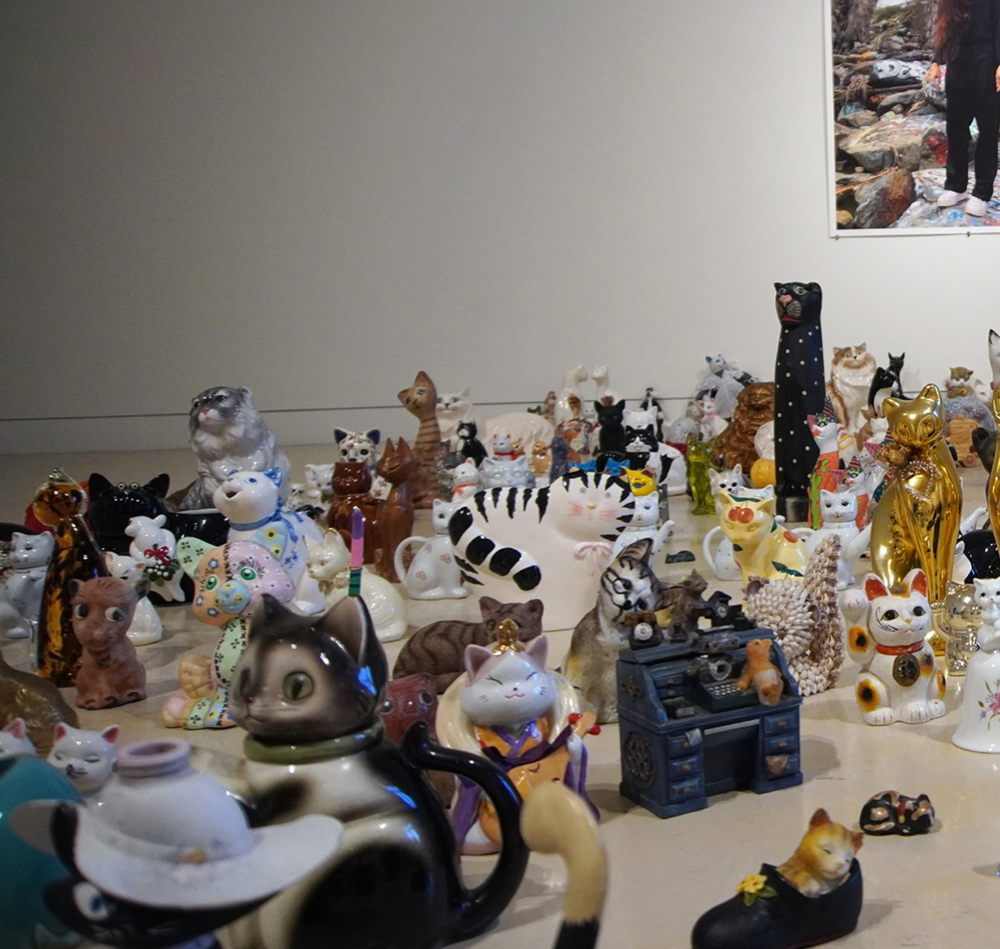
Tessie Salcido Whitmore, Krazy Kat Peeking, Collected Figurines, Dimensions Variable,
2018-Ongoing
Tessie Salcido Whitmore
Tessie Salcido Whitmore’s work is about identity, hidden and discovered. Her aesthetic choices are influenced by her time on the road following the Grateful Dead; California counter-culture; her childhood spent in a matriarchal household of New Age holistic health, philosophies, and religion; and being mixed race. She explores this through the act of collecting and letting materials come together in odd ways. Using quotidian materials, such as found objects, 99-cent store colorful seasonal items, and common household goods, She is interested in finding a mystical sense in the mundane. She creates installations, sculptures, and photographs that use a lens of pop and counter-culture to investigate representations of women, domesticity, the other, and New Age religion.
For I Rang A Silent Bell, Salcido Whitmore amassed ceramic cat figurines from flea markets and thrift stores. Arranged in a field across the gallery floor, they suggest the cultural trope of the “cat lady.” This term refers to a middle age or elderly woman, single and sexless, living with numerous felines. At its most dramatic, the figure conjures images of an unkempt woman in her bathrobe, rarely leaving the house. The history of the figure has changed over time. Its origins lie in the Middle Ages, when it was associated with witches and signified evil, sin, and manipulative female sexuality. It was in the Victorian period that the cat came to be associated with the “old maid” stereotype, being the “friend of the friendless.” In the early 1900s, anti-suffragette propaganda featured cats to ridicule women as they sought the vote. The notion of the cat lady as an eccentric spinster has long served to belittle women living outside the bounds of traditional gender expectations. Yet today, many women are beginning to unapologetically take up this identity and subvert its history. In this installation, both the artist and the viewer become the cat lady as they step into a mob of felines.
The work also draws from the artist’s interest new age spirituality and mysticism. She creates talismans out of found objects—“low culture” items that act as symbols, ordinary things transformed through artistic intention. The photographs in the installation suggest this interest, while harkening back to the cat lady’s association with witches. The images present the artist herself, a lone figure gathering plants in a field and posing amidst clamorous graffiti. In these cryptic compositions Salcido Whitmore appears wild and strange; she is the witch, the crazy cat lady. The title is a lyric taken from the Grateful Dead song, “China Cat Sunflower,” which features kaleidoscopic, cosmic imagery. “China Cat” references both a type of ceramic and the long tradition of cat figurines that serve as luck talismans in Asian cultures. The installation also suggests the multilayered term “pussy,” which, like the cat lady, has a long linguistic tradition. The word, as used to describe a cat, originated in the sixteenth century, and in the seventeenth century came to refer to girls or women. “Pussy” was first used to indicate the vagina in the eighteenth century, while later coming to imply weakness. Today, depending on the intention of its usage, the term oscillates between demeaning and empowering, erotic and political. In Salcido Whitmore’s installation, pussies dominate the space as she both humorously embraces and critiques the cultural meaning of her found materials.
Tessie Salcido Whitmore received her MFA from Claremont Graduate University and her BFA in Drawing and Painting from California State University, Long Beach. She was nominated for the Rema Hort Mann Foundation Emerging Artist Grant and was the recipient of the OC Art Grant and the Albert B. Friedman Grant Award. Recent shows include a solo project, I Rang a Silent Bell at Art Produce Gallery; A Show about Touching at Bread and Salt Gallery; Magick is Afoot at Arvia; Parallels to a Fictional Universe, L’oiseau présente and Botschaft, for Berlin-LA Connect; High Key: Color in Southern California at SDAI; Bitter Candy at Vermont Studio Center; Rob Pruitt’s Flea Market, organized by Nomadic Division; and Floor Flowers, curated by David Pagel.

Stay Connected